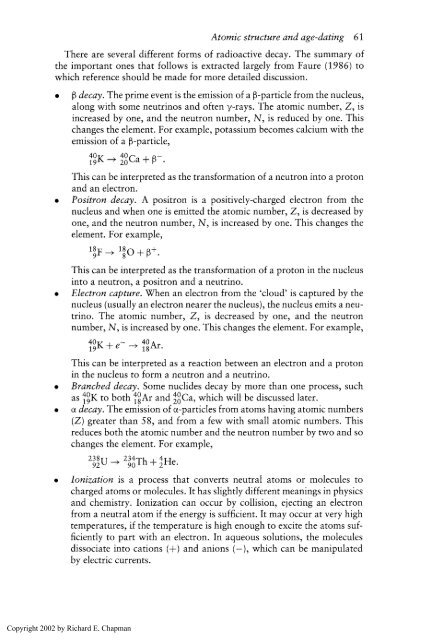Physics for Geologists, Second edition
Physics for Geologists, Second edition
Physics for Geologists, Second edition
Create successful ePaper yourself
Turn your PDF publications into a flip-book with our unique Google optimized e-Paper software.
Atomic structure and age-dating 61<br />
There are several different <strong>for</strong>ms of radioactive decay. The summary of<br />
the important ones that follows is extracted largely from Faure (1986) to<br />
which reference should be made <strong>for</strong> more detailed discussion.<br />
B decay. The prime event is the emission of a B-particle from the nucleus,<br />
along with some neutrinos and often y-rays. The atomic number, Z, is<br />
increased by one, and the neutron number, N, is reduced by one. This<br />
changes the element. For example, potassium becomes calcium with the<br />
emission of a B-particle,<br />
:;K + ;:ca + B-.<br />
This can be interpreted as the trans<strong>for</strong>mation of a neutron into a proton<br />
and an electron.<br />
Positron decay. A positron is a positively-charged electron from the<br />
nucleus and when one is emitted the atomic number, 2, is decreased by<br />
one, and the neutron number, N, is increased by one. This changes the<br />
element. For example,<br />
18 + ':o + @+.<br />
This can be interpreted as the trans<strong>for</strong>mation of a proton in the nucleus<br />
into a neutron, a positron and a neutrino.<br />
Electron capture. When an electron from the 'cloud' is captured by the<br />
nucleus (usually an electron nearer the nucleus), the nucleus emits a neutrino.<br />
The atomic number, Z, is decreased by one, and the neutron<br />
number, N, is increased by one. This changes the element. For example,<br />
I~K + e- -+ :t~r.<br />
This can be interpreted as a reaction between an electron and a proton<br />
in the nucleus to <strong>for</strong>m a neutron and a neutrino.<br />
Branched decay. Some nuclides decay by more than one process, such<br />
as ;K to both ; i~r and ::ca, which will be discussed later.<br />
a decay. The em~ssion of a-particles from atoms having atomic numbers<br />
(2) greater than 58, and from a few with small atomic numbers. This<br />
reduces both the atomic number and the neutron number by two and so<br />
changes the element. For example,<br />
238 S2U -+ 2i;f~h + ; ~e.<br />
Copyright 2002 by Richard E. Chapman<br />
Ionization is a process that converts neutral atoms or molecules to<br />
charged atoms or molecules. It has slightly different meanings in physics<br />
and chemistry. Ionization can occur by collision, ejecting an electron<br />
from a neutral atom if the energy is sufficient. It may occur at very high<br />
temperatures, if the temperature is high enough to excite the atoms suf-<br />
ficiently to part with an electron. In aqueous solutions, the molecules<br />
dissociate into cations (+) and anions (-), which can be manipulated<br />
by electric currents.






